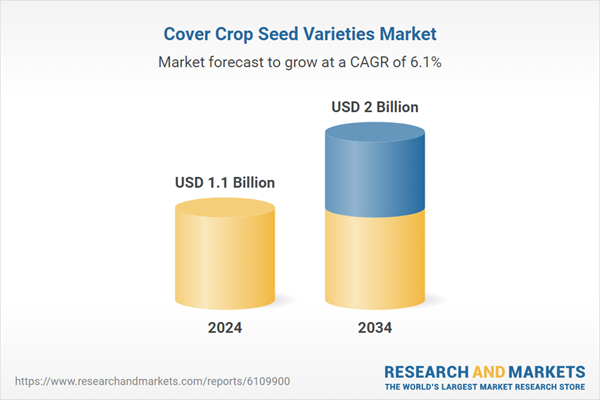Farmers are turning to cover crops as an effective part of crop rotation systems and conservation tillage. These seeds help retain moisture in the soil, improve organic content, and foster biodiversity on farmlands. With climate variability becoming a persistent challenge, newer seed technologies are addressing these concerns by developing drought- and disease-resistant varieties, particularly for regions with arid conditions. Additionally, advancements in precision agriculture are enabling more strategic deployment of cover crops to improve farming efficiency and outcomes. The push toward sustainable productivity is encouraging the adoption of cover crop seeds as a reliable solution to meet environmental targets while maintaining output. As a result, the market is seeing growing interest from both small-scale and commercial farmers who want to integrate eco-friendly methods into their operations.
In 2024, legumes dominated the market by crop type, securing 44.8% of the global revenue share, and are anticipated to grow at a CAGR of 6% through 2034. These seeds are favored for their ability to naturally fix atmospheric nitrogen through microbial activity, significantly reducing the reliance on synthetic fertilizers. Their fast germination, adaptability across diverse climates, and ability to improve soil structure make them a practical choice for farmers aiming to adopt low-impact agricultural systems. These benefits collectively contribute to improved yields and enhanced soil quality, further strengthening the segment’s stronghold in the market.
Grasses, such as rye, oats, and barley, also hold a significant portion of the market due to their performance in ground coverage, soil stabilization, and weed suppression. Although these varieties are not major nitrogen contributors on their own, they play a key role in producing biomass and protecting the soil surface. These crops are commonly used in tandem with legumes to achieve both nutrient enrichment and erosion control. Brassicas, which include species with deep-rooting systems, are used for soil decompaction and pest management. However, their share remains lower than legumes and grasses, mainly because their benefits are more specialized and dependent on specific soil conditions and pest dynamics.
By application, soil health improvement stood out as the leading segment with a market size of USD 336.5 million in 2024 and is poised to grow at a CAGR of 6.2% by 2034. The rising focus on regenerative agriculture has led farmers to increasingly invest in cover crop seed varieties that can boost organic matter, promote microbial activity, and enhance the structural integrity of soil. As these crops hold the soil in place and reduce runoff, they contribute directly to preventing nutrient loss and enhancing the long-term viability of farmland. Moreover, their natural role in nitrogen fixation and carbon sequestration helps reduce the need for chemical inputs while offering ecological benefits such as biodiversity enhancement and improved water infiltration.
In terms of end use, corn-soybean rotation systems accounted for USD 394.6 million in 2024 and are forecasted to grow at the highest rate of 6.4% CAGR through 2034. These systems are widely practiced in large-scale agricultural regions and have gained traction for their ability to maintain soil fertility while breaking pest and disease cycles. Cover crops are increasingly being integrated into these rotations to reduce nitrogen loss, prevent erosion, and suppress weed populations. The compatibility of cover crops with conservation efforts makes this segment a preferred choice for producers focusing on long-term sustainability and yield reliability.
Regionally, the United States led the North American market, with a valuation of USD 315 million in 2024, expected to grow at a CAGR of 6.3% through 2034. The country’s dominance can be attributed to its large-scale farming operations, early adoption of sustainable agricultural practices, and policy support through incentives and regulatory frameworks that promote environmental stewardship. Increasing awareness among producers and growing consumer demand for sustainably sourced food has also contributed to the rapid growth of cover crop adoption across the country.
Leading companies in the global cover crop seed varieties market include Bayer Crop Science, Corteva Inc., Syngenta Group, KWS Cereals, and Green Cover Seed. These players continue to expand their product portfolios and leverage strong distribution networks to meet the evolving needs of farmers worldwide, further shaping the trajectory of this growing market.
Comprehensive Market Analysis and Forecast
- Industry trends, key growth drivers, challenges, future opportunities, and regulatory landscape
- Competitive landscape with Porter’s Five Forces and PESTEL analysis
- Market size, segmentation, and regional forecasts
- In-depth company profiles, business strategies, financial insights, and SWOT analysis
This product will be delivered within 2-4 business days.
Table of Contents
Companies Mentioned
- Bayer Crop Science
- Corteva Inc.
- Syngenta Group
- KWS Cereals
- Green Cover Seed
- Kings AgriSeeds
- GO Seed
- Troy Cover Seed
- GS3 Quality Seed
- Walnut Creek Seeds
- Stokes Seeds
- CoverCress Inc
- Benson Hill
- Cibus
Table Information
| Report Attribute | Details |
|---|---|
| No. of Pages | 245 |
| Published | June 2025 |
| Forecast Period | 2024 - 2034 |
| Estimated Market Value ( USD | $ 1.1 Billion |
| Forecasted Market Value ( USD | $ 2 Billion |
| Compound Annual Growth Rate | 6.1% |
| Regions Covered | Global |
| No. of Companies Mentioned | 14 |









